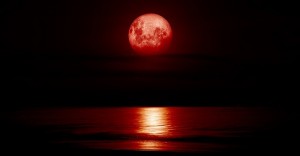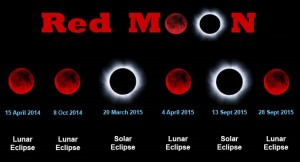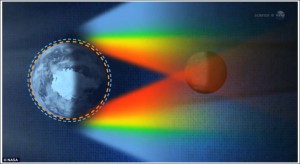 If you missed the blood moon earlier this year, be sure to set your alarm because another total lunar eclipse will return to the sky early Wednesday morning.
If you missed the blood moon earlier this year, be sure to set your alarm because another total lunar eclipse will return to the sky early Wednesday morning.
The historic series of lunar events continues with the second and last blood moon of 2014. This will be the first time in over 400 years that 2 blood moons were visible in one year in America. What’s even more remarkable is that it will happen again next year. The first total lunar eclipse of 2014 occurred on April 15 and it was visible across most of North America, South America, Hawaii and parts of Alaska.
 Tonight, on east coast of the United States, most skies will be clear to allow for an incredible view of the blood moon anywhere east of a line extending from Sault Ste-Marie, Mich. to Paducah, Ky. to Baton Rouge, La.. If you can wake up during the predawn hours of Wednesday, trust us, it will be worth missing a couple hours of sleep.
Tonight, on east coast of the United States, most skies will be clear to allow for an incredible view of the blood moon anywhere east of a line extending from Sault Ste-Marie, Mich. to Paducah, Ky. to Baton Rouge, La.. If you can wake up during the predawn hours of Wednesday, trust us, it will be worth missing a couple hours of sleep.
The upcoming series of blood moons and solar eclipses will be spectacularly beautiful astronomical events over the next two years.
The tetrad — or four consecutive and complete lunar eclipses occurring at approximately six-month intervals — will all be visible over the United States this year and next, according to NASA lunar eclipse expert Fred Espenak.
 NASA’s Espenak does not consider tetrads as particularly rare, noting in a statement that there are nine sets of tetrads during the 21st century. He notes that there have been periods with no tetrads, notably from 1600 to 1900.
NASA’s Espenak does not consider tetrads as particularly rare, noting in a statement that there are nine sets of tetrads during the 21st century. He notes that there have been periods with no tetrads, notably from 1600 to 1900.
“The most unique thing about the 2014-2015 tetrad is that all of them are visible for all or parts of the USA,” Espenak said in a statement.
The full eclipse is known as a “blood moon” because, NASA explains, the sunset red glow that rings the Earth as it blocks the light from the sun is cast upon the moon. During a total lunar eclipse, the moon is entirely immersed in Earth shadow, and can take on a dusky “blood red” color due to the scattering of sunlight through the edges of Earth’s atmosphere. Such moons are sometimes nicknamed “Blood Moons.”
[facebook][tweet][digg][stumble][Google]
[one_third] [/one_third] [one_third] [/one_third] [one_third_last] [/one_third_last]





